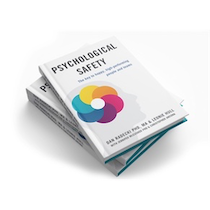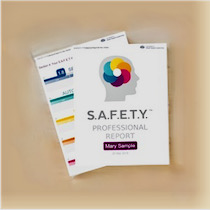Building psychological safety:
one brain at a time
What is Psychological Safety?
Feeling exhausted, worn out, rode hard and put away wet, beaten up, or generally stressed and undervalued? Or are you living the dream, your work is meaningful, you feel free to be your authentic self and express your ideas? Or maybe you are somewhere in between. Wherever you find yourself psychological safety is likely playing a significant role in determining your experience.
Most of us understand the importance of protecting ourselves and those around us in a physically safe way. For example, we typically learn at a young age that hitting someone with your fist when you are angry is generally socially unacceptable and not conducive to sustainable healthy relationships or personal wellbeing. As such there are well-defined parameters about what is socially acceptable, what is helpful, and what is harmful when it comes to physical interactions with ourselves and others. Psychological safety, however, is a new frontier, and we are only now beginning to understand its importance and impact. For example, research shows that a ‘hit’ to our psychological safety can have a deeper and longer lasting impact than a physical ‘hit’. In fact, social rejection has the same impact on the brain as a punch to the face. The difference being that over time the pain associated with a physical attack is difficult or impossible to recall, while recalling a memory of social rejection, many years after the fact, can elicit the same strength of emotion as it did at the time of the event.
When we experience an attack to our psychological safety our brain is triggered into a stress response where our cognitive abilities are compromised and our higher, logical brain that is responsible for thinking, creativity, decision making and self-control, goes offline. In this derailed stress state we can find it difficult to concentrate, make decisions or control our emotions. So on a personal level, maintaining psychological safety is an important factor for optimizing our performance and wellbeing.
It’s link to high-performing teams
From a broader perspective psychological safety has been identified as a critical factor for effective work teams. In fact, the term Psychological safety was originally coined by Harvard Business School professor Amy Edmonson whose research focused on psychological safety as is it applies to work teams. In this context Edmondson defined psychological safety as
“a belief that one will not be punished or humiliated for speaking up with ideas, questions, concerns or mistakes,
and that the team is safe for interpersonal risk taking.”
In a climate where members feel psychologically safe they are not afraid to express themselves and they feel accepted and respected. This openness creates a fertile environment for thinking, creativity, innovation and growth and leads to more effective members, more collaborative relationships and an overall improvement in team productivity.
Edmondson identified that psychological safety was most critical for teams in times of uncertainty and where there was interdependence within the team, which, in our experience, tends to cover the majority of functioning teams. More recently psychological safety has gained increased attention due to the compelling research done in 2015 by Google known as the Aristotle Project. In its quest to build the perfect team Google wanted to assess the factors that contributed most to their high performing teams. They looked at a couple of hundred teams within their company over a two-year period and were shocked to find it was not the background, the experience or the education of the team members that determined the team’s success, but whether psychological safety was present within the team.
So the data from both scientific and industry research suggest that paying close attention to psychological safety has tangible benefits, not just to personal health and wellbeing, but to workplace productivity and performance.
So if the implications of harming psychological safety are so damaging,
and the benefits of protecting psychological safety so great,
why don’t we give it the same attention in society as we do physical safety?
The root of Psychological Safety
The fact is, until more recently we haven’t had the knowledge or tools to unpack psychological safety. The logical starting place was its root – the brain, yet we lacked the ability to measure, track or implement strategies for something so personal, subjective and invisible.
Thanks to breakthroughs in neuroscience research the landscape has changed. We have now gained valuable insight into the brain, its operating principles and the nonconscious drivers that impact our sense of psychological safety.
In our experience psychological safety is built one brain at a time. Through brain-based awareness, strategies, language and tools we now have what we need to be able to communicate, protect and nurture our own and other’s psychological safety.
The S.A.F.E.T.Y.™ Model
It’s crucial, now more than ever, to create some self-awareness around what drives and triggers our psychological safety. Based on neuroscience research The S.A.F.E.T.Y.™ model was created to do just that ….. help you understand how you derive your psychological safety and how you are driven. The S.A.F.E.T.Y.™ domains are universal social drivers that all brains require to feel psychologically safe, and when they are not met we experience stress. They are Security, Autonomy, Fairness, Esteem, Trust and You.
Now while we all need these domains to feel psychologically safe, they tend to exist on a continuum, whereby some are more important than others. Understanding which domain is most important to you will help you generate some self-awareness around potential sources of stress, and what you can do to manage your brain’s safety to optimize your health and performance.
Building Psychological Safety
The S.A.F.E.T.Y.™ Assessment a validated tool to quantify which of these domains is most (and least) important to your brain in your quest for psychological safety. The professional report reveals your brain’s S.A.F.E.T.Y.™ profile and preferences to help build self-awareness around what triggers your brain, how it may impact others and how to manage those triggers. In a team environment sharing team member’s profiles and how they derive their sense of psychological safety, as well as the team’s S.A.F.E.T.Y.™ profile helps to build awareness and appreciation for the diversity of S.A.F.E.T.Y.™ needs on the team, and the practical strategies to nurture needs to foster psychological safety.
For a deeper understanding of the brain-based approach to building Psychological Safety read the book ‘Psychological Safety: The key to happy, high-performing people and teams’.











